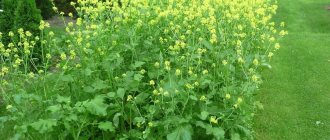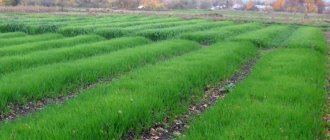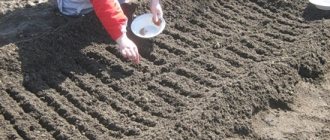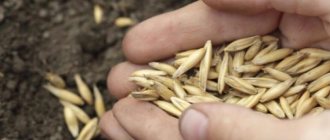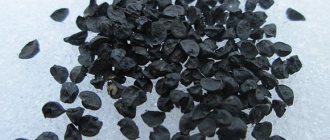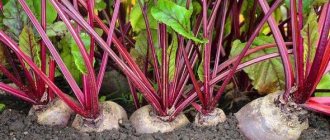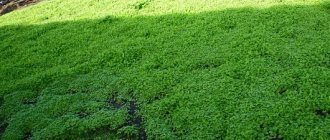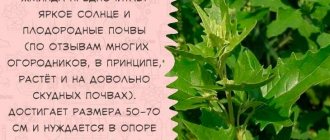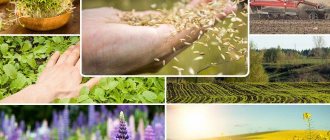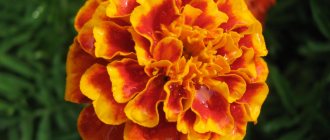Among all the green manure crops used by Russian gardeners, the most popular is mustard.
Dear readers! For you, we have created communities on social networks in which useful articles and interesting ideas are published several times a day! Subscribe and receive useful content in a convenient format!
This green manure does not require any care, grows well and performs its functions perfectly.
In this article we will talk about the timing and methods of sowing and harvesting mustard.
Why sow mustard
Let's start with the question of why sow mustard in your garden at all.
- This plant disinfects the soil using special glycosides.
- A special essential oil suppresses the development of pathogenic microorganisms that are the causative agents of blackleg, root rot, scab and some other less common diseases.
- It saturates depleted soils and maintains the number of microorganisms.
- Mustard contains phosphorus, glucose, potassium sulfate, regular potassium, nitrogenous compounds, and various beneficial essential oils.
- The tops are suitable for processing and further consumption by poultry and livestock.
- Roots improve aeration and soil structure.
- Rotting tops are an excellent natural fertilizer.
- During the growing season, weeds are suppressed.
- The soil under this green manure plant is “resting”.
- Protection of soil from erosion and washout.
- When planting winter crops, they retain the snow cover, which leads to soil moisture in the spring.
Effect on other plants
Mustard has a positive effect on nearby growing vegetation and on crops that will be planted after herbal soil treatment for a number of reasons:
- The soil is enriched with microelements of nitrogen and phosphorus, which the green mass actively releases.
- The growth of weeds is prevented due to rapid growth.
- The soil structure improves.
- The soil is disinfected, cleaned of late blight, scab and putrefactive microorganisms.
- The destruction of pests is ensured, especially wireworms, slugs and moths.
- It has the ability to retain nitrogen, which prevents land leaching.
- The soil is mulched, ensuring that it retains moisture.
- Stimulates growth while simultaneously protecting potatoes, beans, grapes and fruit plants from pests.
When to sow mustard at different times
Another good thing about mustard is that it can be sown to fertilize the soil at any time except, of course, for those months when there is snow in the garden.
The culture grows quickly, and the effect of its use will be noticeable almost immediately.
Let's figure out when to sow green manure at different times of the year.
Sowing mustard in spring
Spring planting of green manure to fertilize the soil is most common.
The agricultural technology for planting is as follows. Sow to a depth of no more than 3 cm. Try to maintain about 15 cm between rows
It is not necessary to make grooves. To sow quickly, bury the seeds in the soil. Use a rake to seal.
ADVICE. If you decide to sow mustard in a risky farming area, then cover the crops with agrofibre. This way the shoots will appear faster.
If we talk about sowing time, it is March. You need to choose a day so that there is at least 1 month left before planting the main vegetables and berries. In the southern regions of our country, sowing green manure to fertilize the soil can be done even at the end of February.
Mustard as green manure in summer
In summer, green manure is sown to restore soil fertility. You can also plant mustard seeds in an area intended for sowing winter crops.
In summer, mustard can be sown twice. The first time was at the very beginning of June. By mid-July, the plants can be mowed and buried in the ground. And in early August, sow a second batch of green manure.
Just by mid-September, the grass can be mowed, and in early October, vegetables can be planted for winter.
Mustard for fertilizing the soil in autumn
In autumn, green manure is used to fertilize the soil and restore its fertility.
Autumn sowing is advantageous in that a large area can be planted with seeds.
Planting time is mid to late October. But you need to do it before the frosts start, since the seeds will not sprout in frozen soil.
The agricultural technology of sowing is slightly different from spring planting. Depth - at least 5 cm (preferably 7). The distance between the rows is slightly larger - 17 cm.
You can sow in rows, or you can scatter them over the surface. Please note that when scattering seeds, more is spent and the planting will be uneven.
After sowing, the land is harrowed.
Mustard as green manure
Mustard is an accessible annual plant from the cruciferous family that is accessible to everyone and very easy to grow. It is very effective for use as a natural fertilizer.
Its seeds look like small beans, which sprout quickly after planting and are capable of gaining good green mass in a short time. In 1 month the plant grows 20-25 cm (!). Such rapid growth allows mustard to be considered one of the best green manures for autumn cultivation, when time is very limited.
In all its parts, both aboveground and underground, mustard contains a sufficient amount of easily digestible elements and is a natural vermicompost in its composition. As a result, the soil is well structured, and phosphates and microelements that are difficult for cultivated plants are released.
The roots of mustard go very deep into the ground, thereby loosening it perfectly. This increases the breathability of the soil.
Planting mustard as green manure
Mustard will save the soil from erosion. If there is a threat of soil erosion or damage by winds in the autumn-spring period, then a densely sown plant will protect against these problems.
It has also been noted that white mustard suppresses the growth of weeds.
In terms of the effectiveness of its impact on soil fertility, white mustard at the stage of 40-50 days is equivalent to the application of 400-600 kg of semi-rotted manure
Since mustard contains essential oils, it has a pronounced insecticidal effect against soil-dwelling pests. Planted in the garden, it will protect the future harvest from:
- pathogens of late blight, fusarium, rhizoctonia;
- nematode formation;
- harmful microbes and bacteria;
- pests such as wireworms, onion and carrot flies, slugs, etc.
Packet of white mustard seeds
How to sow mustard correctly step by step, sowing features
Step 1. Site preparation. Weeding, garbage removal, digging and loosening the soil.
Step 2. Preparation of planting material. Soaking in a heteroauxin solution (0.6 ml per 1 liter of water) for 6 hours.
Step 3. Choosing a planting method. The grains can be scattered or sown in rows. If you choose a row planting method, then draw the future rows with a garden marker.
Step 4. Landing. Scatter or sow the seeds in rows. The consumption rate is about 400 grams per hundred square meters.
Step 5. Sprinkle with soil. You can simply fence it with a rake.
Step 6. Watering. You can water from a watering can or from a hose but with a nozzle.
ON A NOTE. If you use green manure not for fertilizer, but to protect garden crops, then plant green manure in rows between the beds with the main crops. However, make sure that the mustard does not obscure the vegetables!
Sowing mustard in autumn
Winter green manures are sown very thickly. You can sow the beds completely, or you can sow them in rows. The area freed from vegetables is cleared of tops and weeds, and if the soil on it is depleted, phosphorus-potassium fertilizers or Nitroamophoska are added to it for digging to a depth of 20-25 cm at the rate of 30-40 g per 1 m². Dry soil is moistened before sowing green manure.
In areas with early ripening crops, green manure can be sown twice in the fall: the first time in August with crops with a short development period, for example, beans, barley and peas. Grown green manure plants are mowed at a height of 20-25 cm and shallowly embedded in the soil, where they have time to decompose before the onset of cold weather. Pre-winter sowing (the second for early-harvested crops and the main one for late crops) is carried out in the second ten days of September or the first ten days of October, sowing the beds with sweet clover and winter rye.
Latest articles about gardening
Growing gloxinia from seeds at home
How to grow lavender from seeds in open ground
Growing gladioli in open ground
After which crops you can and after which you cannot sow mustard
The plant can be sown in the garden as a green manure after crops from the Solanaceae, Pumpkin, Bulb, and Legume families. That is, after almost all the vegetables that are grown in an ordinary Russian garden.
With one exception. It is forbidden to grow mustard in areas where cabbage (white cabbage, cauliflower, kohlrabi, Brussels sprouts), radishes and radishes grew before it.
The fact is that these plants, like the green manure we are considering, belong to the same cruciferous family. This means that cultures tend to suffer from the same diseases. That is, there is no point in sowing mustard.
When to put mustard
Mustard is harvested from the site approximately a month (maximum one and a half months) from the moment the first shoots peck.
Mow the plants. If there are few of them, you can cut them off with a sickle. Next, the tops are crushed and scattered around the site.
Then the garden needs to be dug up. If you have a cultivator, it is better to use it. Then watering is carried out.
ON A NOTE. To make the tops quickly decompose and turn into fertilizer, you can use Baikal-EM.
You need to have time to remove mustard before flowering and seed formation. Otherwise, there is a risk that the crop will fill the entire garden and will no longer become green manure, but a real weed.
In addition to this obvious reason, you need to mow the mustard in time, since the plant will spend a lot of nutrients on flowering and producing seeds, and, therefore, will be less useful for the soil.
When does sowing begin?
Mustard is sown during the “rest” of the soil (green manure fallow), in the inter-row spaces during the development of the main crop. Also, depending on its purpose, mustard is grown in spring, summer and autumn.
in spring
Early sowing of mustard is justified as:
- “green manure” (green manure);
- companion plants;
- honey plant;
- source of vitamins and microelements in the human diet.
Thanks to the spring planting of mustard, it is possible to reduce the growth and spread of weeds throughout the area.
Start sowing the crop in early spring, as soon as the snow has melted. Depending on the climate, the start of planting mustard seeds in Russia varies:
- for the middle zone - March;
- for the southern regions - the 20th of February;
- for the northern ones - April.
Focus not only on long-term temperature charts for the region, but also on the weather forecast in case of late spring.
The plant is cold-resistant, can withstand frosts down to -6 °C. Seeds germinate even at +1...+2°C, and at temperatures of 10°C and above, the first sprouts will appear within 3-4 days after sowing.
If you use an annual as green manure:
- Mow mustard before or at the initial stage of flowering (i.e. 30-40 days after planting). By this time, the plant will have gained the optimal volume of green mass.
- Dig up the soil with a shovel.
- Water in dry weather.
Due to the shallow root system, plants are watered abundantly at all stages of growth.
- Use EM drugs. These concentrates contain beneficial microorganisms that accelerate the breakdown of plant fibers and promote the rapid formation of humus.
- Plant the main crop no earlier than a week after planting green manure into the soil. Unrotted remains of green mass will slow down the growth of vegetables.
In summer
To restore, improve and enrich the soil, planting mustard in the summer is suitable. During this season, the crop is sown on lands that:
- removed from crop rotation;
- protect from weeds after harvest.
When rotating crops, follow the rules:
- To use the fallow time more efficiently, sow annuals twice a season: at the end of May and in mid-July.
- Keep an interval between sowings of 2 weeks, give soil microorganisms time to process organic matter.
- Mow and plant plants that are in the flowering phase. If you miss the deadline, mustard seeds will form and scatter throughout the area.
in autumn
To prevent the vacated soils from becoming covered with weeds, sow the empty beds with mustard within 2-3 days after harvesting.
It is especially important not to delay agricultural work in the northern regions. Winter starts early there. If you delay sowing, there is a risk that the mustard will not have time to grow before the frost arrives. In the south of Russia, the crop can be planted until late autumn.
In the autumn, it is important to sow mustard as a green manure and to protect the soil from dehydration, freezing, blowing out, and washing out.
There are two ways to deal with grown mustard:
- Mow it if the plants have grown to a height of 17-20 cm. Then they dig it up or leave it lying on the surface of the ground until spring (as mulch).
- They are left in the beds if the mustard has not had time to grow, frost has occurred and the soil is frozen.
How to sow mustard after harvesting potatoes
Potatoes in our country are dug up in August or September, depending on the region.
To allow the soil to restore fertility, as well as suppress the development of pathogenic microorganisms and the proliferation of parasites, green manure such as mustard is planted in this area.
ON A NOTE. This plant will scare away wireworms from the area and will not allow late blight spores to develop.
After harvesting the potatoes, the area must be weeded, all remaining debris removed and, if necessary, dug up. Next, mustard seeds are sowed. The grains need to be distributed evenly; there is no need to leave empty spaces or, on the contrary, allow the plantings to become dense.
In about a month or so it will be possible to mow down the grown plants and bury them in the soil.
Over the winter, the tops will rot and saturate the garden with useful nutrients. And in this place it will be possible to plant potatoes again.
Benefits for soil and plants
Features of mustard as a fertilizer:
- structures the soil;
- thanks to loosening, water and air penetrate more easily into the soil;
- the tap root holds the fertile layer in one place and protects it from leaching and weathering;
- enriches the earth with nutrients (macro-, microelements, organic compounds);
- the root system absorbs and dissolves the nutrient medium that is inaccessible to other plants;
- provides an ideal environment for the development of earthworms (additional loosening);
- during winter sowing, it retains the snow cover on the site, protecting the top layer from freezing; it is useful to plant next to winter crops;
- reduces the population of harmful insects (wireworms, nematodes, beetles, moths, slugs);
- protects future plantings from infection by pathogenic microflora (fungi, infections).
Advantages and disadvantages of sowing mustard to fertilize the soil
Now it’s time to discuss the pros and cons of using mustard in the garden.
First, the benefits of mustard.
- Extremely easy to care for.
- Resistant to temperature changes.
- It rises quickly.
- “Lifts” useful substances from deep layers of soil.
- Suppresses weeds.
- Attracts pollinating insects to the summer cottage.
Now a few words about the shortcomings (or rather, about the features) of this culture.
- Mustard requires regular watering.
- The crop releases less nitrogen into the soil than other green manures.
- Does not tolerate shade well.
- Does not grow well on clay soils. Does not tolerate salty and acidic soils.
- May develop powdery mildew or leaf spot.
White mustard as fertilizer and care for it
This variety of mustard will protect the area from weeds and saturate the soil with minerals and trace elements. However, if you sow the crop on poor, unprepared soils, there will be no result. Sowing green manure cannot replace the application of fertilizers such as humus or compost. In order for the soil to be healthy and fertile, it is necessary to carry out a whole range of measures.
The culture is unpretentious in care and will grow in any area, but it is best to cultivate it in a well-drained area. In heavy soil, growth slows down. The plant develops well both in partial shade and in sunny areas, the main condition is long daylight hours.
Shoots appear at temperatures above 10 degrees Celsius after 3-5 days. If you sow mustard in late autumn (for the winter), you need the temperature to drop below these values. With early sowing, a green carpet will cover the ground within a month, and then buds will appear. The flowering period usually occurs after 6-7 weeks, it is long. There is no need for additional feeding. Watering in the garden is carried out only when necessary, if the soil begins to dry out.
Interesting!
The plant is a good honey plant.
Common mistakes
It would seem that what is difficult about sowing mustard seeds in the garden? However, errors still occur. Let's look at the most common ones.
- Mustard is not watered after sowing. The soil under this crop should not be allowed to dry out. Therefore, provide moderate but constant watering.
- After sowing, the garden does not need to be harrowed. Because of this, the seeds are carried by the wind or pecked by birds.
- Mustard is sown in place of cabbage or radish. These are related plants. You cannot plant them side by side or alternate plantings.
- Mowing is done too late. Green manure must be removed before the seeds ripen, otherwise the green manure will turn into a weed and fill the entire garden.
- Planting too often or too sparsely. To maximize the effect, use 400 grams of mustard per hundred square meters (that’s 2.5 kg per 6 hundred square meters). Try to distribute the grains evenly so that there are no empty spaces.
Benefits of mustard for soil
Mustard green manure contains many useful microelements: starch, proteins, sugars. They protect the soil surface from blowing away and washing away. In terms of usefulness, the substance can be compared to manure.
Mustard performs the function of disinfection, increases fertility, protects against spring frosts, diseases and pests.
If you sow mustard seeds in the spring and plow them in as they grow, the soil will be saturated with nitrate nitrogen. He will no longer need additional feeding. In terms of effectiveness, this method can be compared with adding organic matter.
The branched and strong roots of mustard have the ability to loosen the soil no worse than plowing equipment. The plant protects the soil from destruction, prevents the leaching of beneficial microelements from it, releases phosphates, kills weeds and pathogens.
Mustard improves the health of the soil and inhibits the accumulation of pathogenic bacteria, wireworms and nematodes.
The beneficial properties of mustard allow gardeners to increase the positive effect on the soil, spending a minimum amount of money and time.
Answers to frequently asked questions
On what soil can this green manure be planted?
Almost any type of soil except clayey soil. Mustard is a very unpretentious crop.
How to care for green manure plantings?
The main thing is to water if the summer season turns out to be dry. In fact, nothing more needs to be done.
When to mow mustard and bury it in the soil?
In about a month and a half. In good weather conditions - earlier.
For which crops is green manure useful?
For almost all major vegetable crops except cabbage. Mustard crops are grown for potatoes, garlic, tomatoes, eggplants, peppers, and berries.
Where to buy green manure?
Now it is sold in many hardware stores and agricultural markets. Usually this is a package weighing 400 grams. This amount is just enough for 1 hundred square meters.
